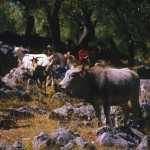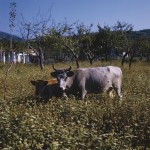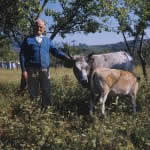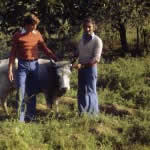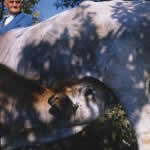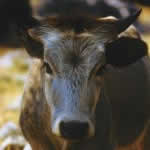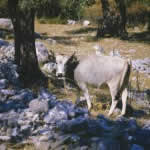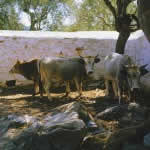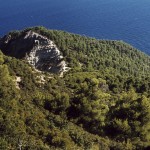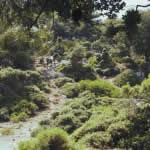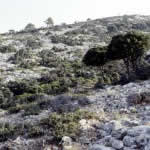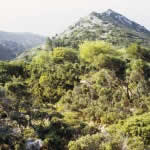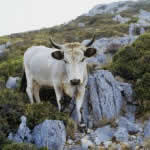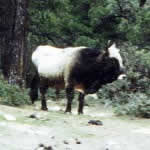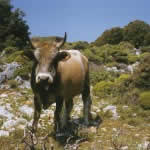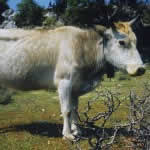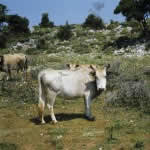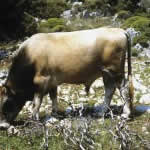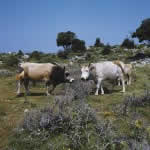On the Northern Sporades Archipelago, all the indigenous stock of cattle became extinct in the early 1990s. This invaluable loss of genetic material is one of the tragic consequences of Greek ignorance and indifference.
These dwarf cattle were adapted to live in dry, rocky habitat and to feed on the sparse grasses and herbs rather than browse on saplings, leaves and twigs as goats do. I tried locally and at ministerial level to save the last herd on Piperi owned by Thomas Lemonis of Skopelos. In vain…the last individuals were shot on Piperi at about the same time when the Marine Park – with Piperi being declared a strict core zone – was officially established. Nobody seemed to have espressed any regret or even taken notice.
The photographs were taken on Piperi (and Skopelos) in 1982, on Gioura in 1976.
The picture of the Piperi bull was taken by Aliki Panou prior to 1980.
The Piperi cattle were presented in two TV documentaries: Rare Breeds in a Changing World (for ERT 1) and Haustiere vom Aussterben bedroht (for ZDF). In both films one can observe how the animals graze on the ground. Evidently, they do not affect trees or bushes.
The three animals on Gioura were kept by the warden. He sold them to the butcher on Alonnisos for 1.800 DMark – very regrettably I was not there at the time to intervene. The cow originated from Kyra Panagia Island, and the bull from Geraka on Alonnisos, as I was told.
For the management of grazing and protection of the higher vegetation cover on the large island of Kyra Panagia, two or three small herds of old breed cattle had been recommended at several occasions. Thus effective measures of avoiding the catastrophic over – grazing that rapidly devastates now this formery very green island (by more than 4.000 goats!) could have been perfectly integrated into the Natinal Park scheme. It should be mentioned that such large numbers of goats are illegal, but they where tolerated by the oficial Park’s management body (and the guarding agency MOm!) knowingly and continuously (cf. the article about Kyra Panagia and other relevant articles under the category „Northern Sporades“).
Attached is my letter of 1976:
Postanschrift: Kaiserstr. 52 D – 8000 München 40
Herrn Marinos Yeroulanos
Executive Secretary
National Council for
Physical Planning and Environment
Ministry of Coordination
München, den 7. Okt. 1976
Betr. Rinderrasse auf den Nördlichen Sporaden
Sehr geehrter Herr Yeroulanos,
Auf Ihren Wunsch hin sende ich Ihnen beiliegend eine Ablichtung des Entwurfs eines Aufsatzes über die Bedeutung von traditionellen Haustierrassen. Daraus können Sie Argumente für die Bedeutung der Erhaltung des sog. Alonnisos – Rindes entnehmen.
Zusammengefaßt ergeben sich folgende Argumente:
Erhaltung der letzten Herde (Besitzer Thomas Lemonis, Skopelos) als genepool für Züchtungen in der Zukunft.
Optimale Anpassung an Inselklima – und Vegetation, damit maximale Ausnutzng der natürlichen Ressourcen der Inseln.
Potentieller Ersatz (partiell) für die ökologisch destruktive Hausziege. Natürlich nicht völliger Ersatz, da die Lebensansprüche etwas verschieden sind. Zusätzlich des Hausschafs.
Widerstandsfähigkeit gegen Krankheiten. Keine Geburtskomplikationen.
Einfache Haltung (Freihaltung).
Es wird vorgeschlagen, die Tiere auf Alonnisos und später auch im Bereich des geplanten Schutzgebietes (Zone II) auf Piperi und Kyra Panagia als freilebende Herden zu halten.
Zu den ökonomischen Aspekten kommt noch der kulturelle: Erhaltung eines bedutenden Traditionsgutes zur Bewahrung der regionalen Identität.
Mit den besten Empfehlungen,
Ihr (Thomas Schultze-Westrum)
On Kyra Panagia in traditional times a herd of approx. 100 heads was kept.
The origin of this breed is the Chalkidiki Peninsula. From the port of Sykia cattle was regularly shipped to the islands.
Still there exist at least one more or less pure herd of the Sykia – cattle on the Calkidike. The last chance to save it will have passed soon!
Cf. also the articles on Alonnisos and Skyros islands with more pictures.
